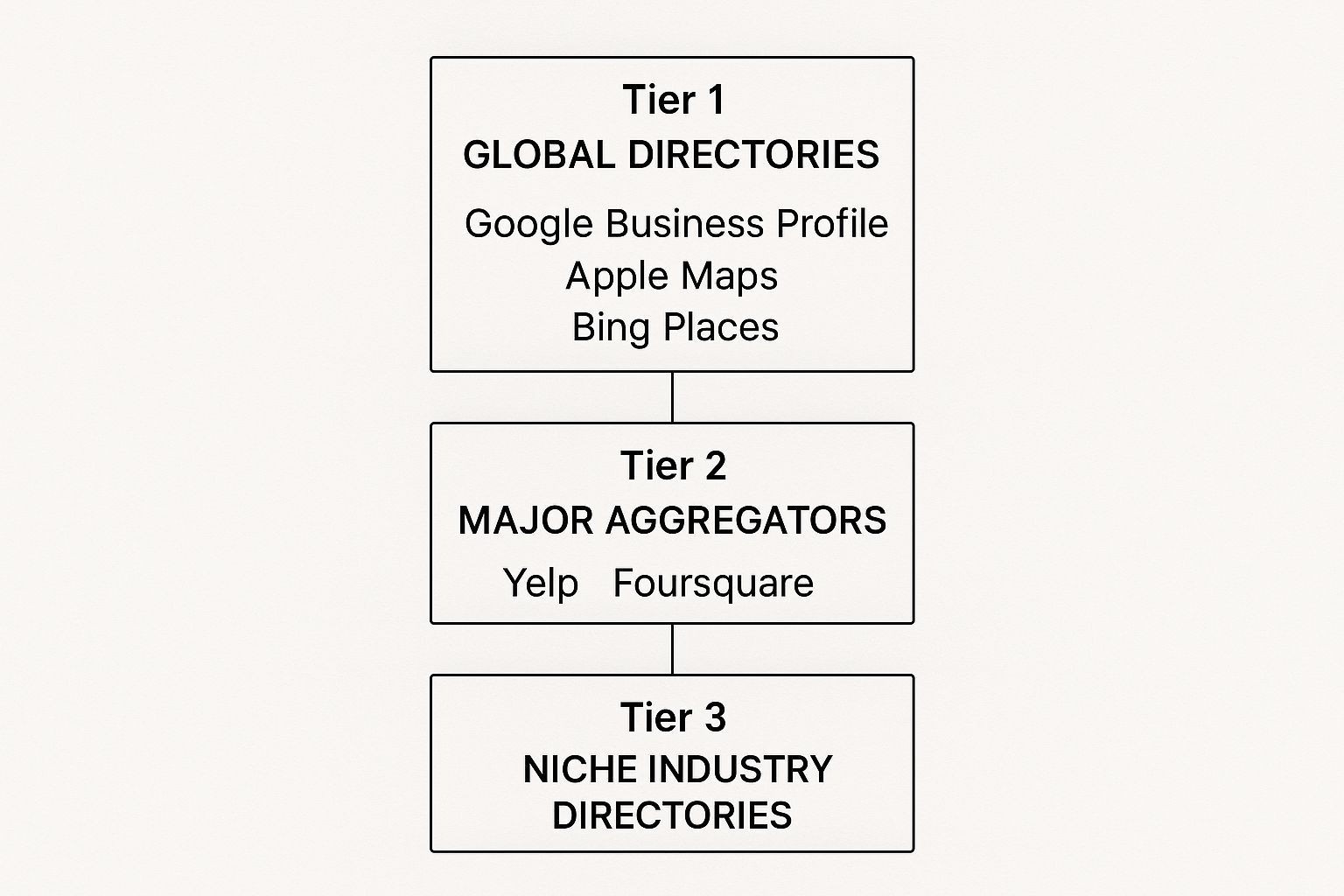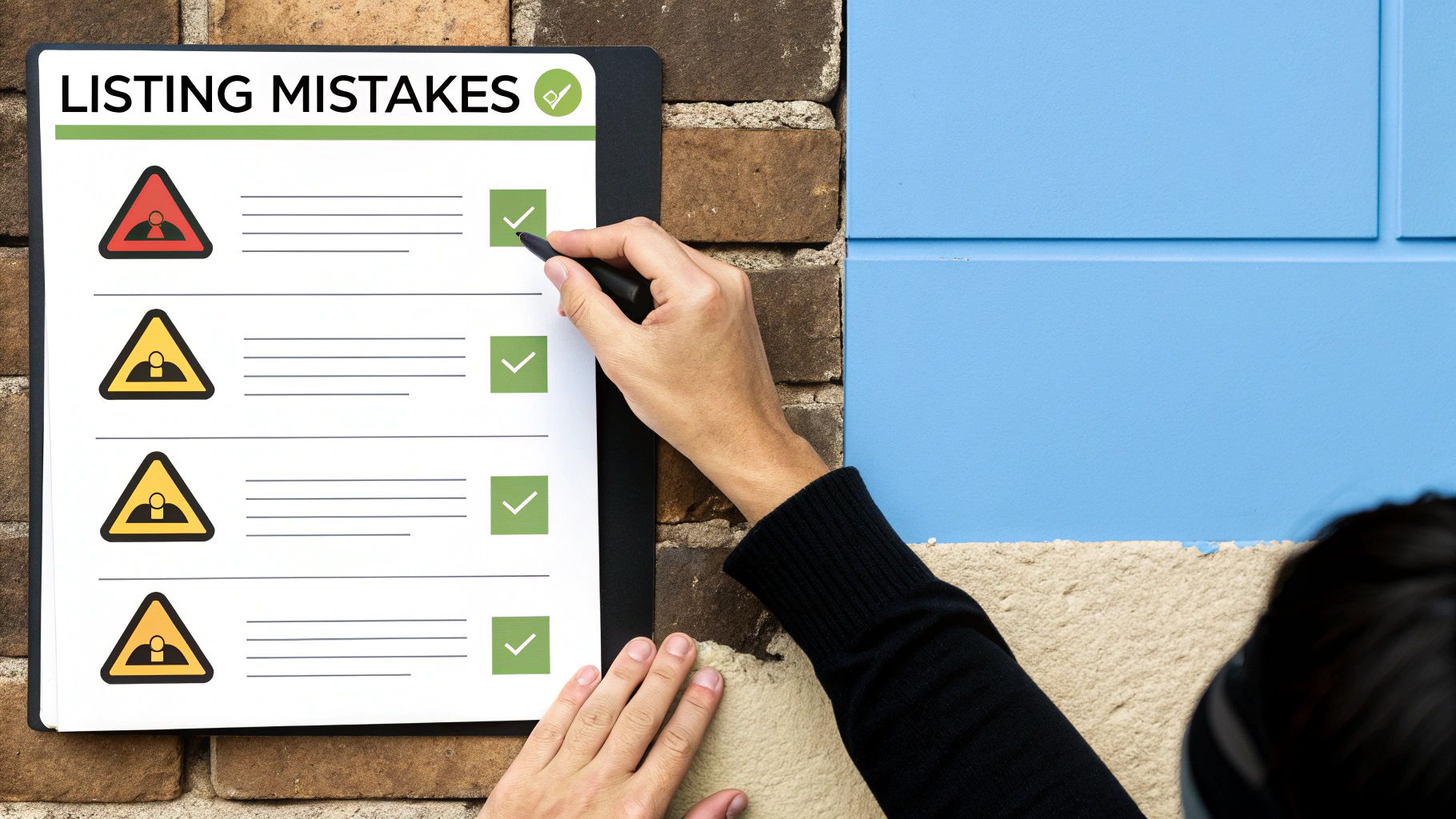Remember the days of flipping through a massive phone book to find a local plumber or restaurant? Local directory listings are the modern-day version of that, but infinitely more powerful. Think of them as your business’s digital storefront, placed on all the key online platforms where customers are actively searching.
What Are Local Directory Listings?

At their core, local directory listings are simply online profiles that contain your business’s essential information. They exist on platforms that people and search engines rely on for local discovery—think Google Maps, Yelp, and even Apple Maps.
When someone searches for “coffee shop near me,” these platforms consult their massive digital address book to provide the best results. Your listing is your entry in that book, ensuring you show up when it counts.
The Core Components of a Listing
Every listing is built around a simple but critical foundation known in the industry as NAP data. This isn’t just random information; it’s the digital fingerprint that identifies your business online.
- Name: Your official business name, spelled out exactly.
- Address: Your full, physical street address—no shortcuts here.
- Phone Number: The main phone number where customers can reach you.
Of course, a good listing goes beyond the basics. It should also include your hours of operation, a link to your website, a list of services, and even photos of your work or location. Each detail helps paint a complete picture for a potential customer.
The goal is to provide a complete, accurate, and compelling profile that answers a searcher’s questions before they even ask them. A strong listing doesn’t just inform—it invites customers to connect.
Why Consistency Is Non-Negotiable
Picture this: you tell three friends three different addresses for a party. Chaos, right? It’s the exact same situation with your business information online. Inconsistent details across different directories create confusion for customers and erode trust with search engines.
When Google crawls the web and finds the exact same NAP data for your business on multiple reputable sites, it confirms you are who you say you are. This consistency is a huge trust signal. In fact, maintaining accurate data across major directories can improve your local search visibility by up to 25%. It’s a non-negotiable factor in ranking well for those all-important “near me” searches. You can find more insights about local citations here.
How Listings Fuel Your Local SEO Engine
Think of your local directory listings as powerful trust signals for search engines like Google. Every consistent listing you create is like a vote of confidence, confirming that your business is real, it’s where you say it is, and it’s open for business.
When search engine crawlers find the same accurate info about you across dozens of reputable sites, their confidence in your legitimacy grows. That confidence is what powers your local SEO, directly impacting how high you rank when a potential customer nearby is looking for your services.
Winning a Spot in the Local Pack
One of the most valuable spots on a Google search results page is the local pack—that little box with a map and three business listings that pops up for local searches. Getting your business in there is a game-changer for visibility.
Landing in this prime real estate isn’t about luck. It’s heavily influenced by having consistent, accurate, and optimized local directory listings. Each correct citation strengthens your digital footprint and proves your connection to a specific geographic area. Without this groundwork, you’re pretty much invisible in the race for those top spots.
Businesses with optimized and consistent directory profiles across multiple platforms experience a 32% higher likelihood of appearing in the local pack. This elevated visibility translates directly into potential revenue gains, making it a critical focus for any local marketing strategy.
Building Digital Authority Through Citations
Every time your business’s Name, Address, and Phone number (NAP) appear together online, you’ve created what’s called a local citation. These citations are the fundamental building blocks of your online authority in a local market. To really dig into how this works within a broader strategy, this guide on Local SEO for Small Business is a fantastic resource.
Here’s an easy way to think about it: imagine you’re lost in a new city and ask for directions. If ten different locals all point you toward the same landmark, you’re going to trust that they’re right. Search engines follow a similar logic:
- Verification: When lots of sources confirm your business details, it proves you’re a real, operational company at your listed address.
- Relevance: Getting listed in industry-specific directories (like a contractor directory) or city-focused sites signals that you’re a relevant choice for those particular searches.
- Prominence: The more high-quality directories you appear on, the more prominent and authoritative your business seems to Google.
This process of gathering trust signals is absolutely vital for long-term success. You can dive deeper into the strategy behind this in our guide to local citations building. A small but consistent effort in managing your listings can create a huge ripple effect, dramatically boosting your visibility and bringing more local customers right to your door.
How to Prioritize the Most Important Directories
When you start digging into local listings, it’s easy to get overwhelmed. There are literally hundreds of them out there. So, where do you even begin?
Trying to be everywhere at once is a recipe for burnout. The key is to be strategic. Focus your energy on the platforms that deliver the biggest punch first, then build out from there. It’s about creating a strong foundation before you start decorating the rest of the house.
Tier 1: The Heavy Hitters You Can’t Ignore
First things first, you need to nail down your presence on the undisputed giants of local search. These are the platforms people turn to every single day for “near me” searches and driving directions. Getting these right is non-negotiable.
- Google Business Profile: Let’s be clear—this is the most important listing, period. It’s what puts you in Google Search and on Google Maps, which is where nearly 50% of all searches for local information happen. A well-managed profile here is your direct line to showing up in the coveted “local pack.”
- Apple Maps: As the default navigation app for every iPhone and iPad user, an accurate listing on Apple Maps Connect is crucial. It’s how millions of Apple users will find your number, get directions, and walk right through your door.
- Bing Places: While Google gets all the headlines, Bing still has a solid chunk of the search market. Claiming your Bing Places for Business profile ensures you’re visible to everyone using Microsoft devices and services, like Windows and the Edge browser.
Think of these three as the pillars of your local online presence. This handy visual breaks down how to approach your listing strategy, starting with the most critical platforms.

This tiered approach keeps things simple. Master the essentials first, then expand your reach.
Top Local Directory Platforms to Prioritize
To help you focus, here’s a quick comparison of the essential platforms and why they matter for your business.
| Directory Platform | Primary Use Case | Key Feature for Businesses | Why It’s Essential |
|---|---|---|---|
| Google Business Profile | Dominant local search and maps | Google Posts, Q&A, and direct messaging | The #1 driver of local discovery and customer interaction online. |
| Apple Maps | iOS navigation and discovery | Rich “Place Card” with photos and integrated reviews | Captures millions of high-intent iPhone and iPad users on the go. |
| Bing Places | Microsoft ecosystem search | Syncs with Google Business Profile for easy setup | Reaches a different segment of the search market, often less competitive. |
| Yelp | Customer reviews and reputation | Review management and direct quotes | A trusted review hub that heavily influences buying decisions, especially for services. |
| Social proof and community | Recommendations, check-ins, and event promotion | Acts as a powerful social signal and customer engagement platform. |
Getting these five platforms right will cover the vast majority of your potential customers and give search engines the strong, consistent signals they need to trust your business information.
Tier 2: Major Review Sites and Data Aggregators
With your foundation firmly in place, it’s time to move on to the next level: major aggregators and review-focused sites. These platforms are highly trusted by both search engines and consumers, and they often supply data to dozens of smaller, niche directories.
Yelp, for example, is still a powerhouse, especially for service-based businesses. Its user reviews and community-driven content can make or break a customer’s decision. Then there’s Foursquare, which provides location data that powers countless other apps and services. Getting listed here reinforces your digital footprint and helps you manage your online reputation.
Think of it like this: The Tier 1 directories are your business’s official ID. The Tier 2 sites are the trusted references that vouch for you, adding layers of credibility that search engines absolutely love.
Tier 3: Niche and Industry-Specific Directories
The final step is to get hyper-focused. This means finding the directories that cater specifically to your industry or city. These platforms attract customers who are already deep in the buying cycle and looking for exactly what you sell.
For example, a home contractor would want to be on a site like Angi, while a restaurant would get huge value from a profile on TripAdvisor. These listings send powerful relevancy signals to Google about your expertise and local authority. Better yet, they often deliver high-quality leads because the audience is so targeted.
By working your way through these tiers methodically, you’ll build a comprehensive and authoritative presence that puts you miles ahead of the competition. For a deeper dive into all the possible places to get listed, check out our complete local directory list.
Getting the Most Out of Your Listings

Just getting your business listed on local directories is only scratching the surface. The real magic happens when you stop thinking of them as static entries in a digital phone book and start treating them as active, dynamic marketing tools. Going beyond the basic name, address, and phone number is what gets you noticed.
Think of it this way: a complete profile is a signal of trust. It tells both search engines and potential customers that your business is legitimate, professional, and ready to engage.
Writing a Business Description That Sells
Your business description is your one shot to make a great first impression. It’s your elevator pitch—a quick, compelling summary of who you are, what you offer, and what makes you the best choice. A generic description is a wasted opportunity.
Don’t just list what you do. Instead, try to weave in the exact phrases your ideal customers are typing into their search bars. For example, a plumber who just says “We fix pipes” is missing out. A much stronger approach would be: “Your friendly Springfield plumber, specializing in 24/7 emergency leak repairs, drain cleaning, and water heater installation.” See the difference? It’s descriptive, packed with keywords, and solves a problem.
Key Takeaway: Your description should be built for customers. It needs to highlight benefits, feel local, and naturally answer the question, “Why should I pick you?” in just a couple of sentences.
Choosing the Right Business Categories
This is a big one. Picking the right business categories is absolutely critical because it tells platforms like Google exactly what you do. Think of them as signposts that direct relevant customers right to your door.
Most sites let you select one primary category and several secondary ones. Be as specific as you can with your primary choice.
- Good: “Italian Restaurant”
- Better: “Pizza Restaurant” (if pizza is your main thing)
Then, use the secondary categories to cover everything else you offer. Our “Pizza Restaurant” could add “Italian Restaurant,” “Catering,” and “Food Delivery Service” to show up in a wider variety of searches. Honesty and accuracy here are key to getting in front of the right people.
Using Photos and Special Features to Your Advantage
Let’s be honest, people are visual. A local listing packed with high-quality photos gets far more clicks, calls, and attention. Your logo is a start, but you need to show people what you’re all about.
- Storefront: A clean, welcoming picture of your entrance.
- Interior: Photos that capture the vibe and what it feels like to be there.
- Products/Services: Sharp, professional shots of what you sell or the work you do.
- Team Photos: Puts a human face on your business and builds instant trust.
But don’t stop with photos. Dig into the unique features each platform offers. Use Google Posts to announce a sale, or build out a project portfolio on Yelp to show off your best work. These tools are designed to drive engagement and give customers every reason to choose you. For an even more detailed walkthrough, our guide to local business listing optimization covers these strategies in greater depth.
Turning Customer Reviews Into Your Best Marketing
Think of your local directory listings as more than just a digital phonebook. They’re living, breathing forums where your reputation is forged with every single customer interaction. And reviews? They aren’t just feedback—they’re incredibly powerful endorsements that sway what 87% of consumers decide to buy.
Each review is a real-time testimonial for your business. A glowing five-star rating is a powerful thumbs-up, but a thoughtful, professional response to a complaint can be just as convincing. It shows you’re listening and you care, which builds a ton of trust with potential customers who are watching from the sidelines.
Actively Encourage Good Reviews
So, how do you get more of those positive reviews? You just have to ask. Most happy customers are more than willing to share their great experience, but life gets in the way. A simple, timely reminder is often all it takes.
- Make it incredibly easy. The fewer clicks, the better. A direct link to your Google or Yelp profile in a thank-you email right after a purchase is perfect.
- Use real-world prompts. A small, friendly sign at your register or a note on a receipt works wonders. You can even get creative by creating a Google Review QR code that customers can scan with their phones.
- Timing is everything. The best time to ask is right after they’ve had that great experience, while the positive feelings are still fresh.
Taking these simple steps puts you in the driver’s seat of your online story. It helps make sure the voices of your happiest customers are the loudest, creating the kind of genuine social proof that brings new people through your door.
How to Handle Every Kind of Feedback
Responding to reviews isn’t optional anymore—it’s a core part of managing your reputation. Remember, your replies are public. They give everyone a window into your company’s personality and how much you value your customers.
Responding to reviews shows you’re engaged and that you care about the customer experience. This public interaction sends a strong signal to both new customers and search engines that your business is active, attentive, and trustworthy.
Always keep it professional. For the good reviews, a personalized “Thank you!” goes a long way. For the not-so-good ones, acknowledge their concern, show some empathy, and offer to take the conversation offline to fix it. This approach can often turn an unhappy customer into a lifelong fan.
Avoiding Common and Costly Listing Mistakes

Managing your local directory listings seems easy enough on the surface, but a few small, seemingly harmless mistakes can undo all your hard work. These common slip-ups don’t just confuse customers; they erode trust with search engines and can send your local visibility plummeting.
The good news? These costly pitfalls are completely avoidable. Once you know what trips most businesses up, you can sidestep them and make sure your listings are a powerful asset, not a liability.
The Problem of Inconsistent Information
The single most damaging mistake you can make is having inconsistent NAP (Name, Address, Phone Number) data across the web. If one directory lists your business on “Main Street” and another uses “Main St.,” search engines see a major red flag. Those tiny discrepancies create doubt, and when search engines are in doubt, your rankings drop.
Think of your NAP as a digital fingerprint for your business—it needs to be identical everywhere you leave it. This consistency, right down to the suite number and the “LLC” in your name, is the absolute foundation of trust for local search algorithms.
A single incorrect listing can spread like a weed. Data aggregators are constantly scraping and sharing information, so one small error on a major platform can quickly multiply into dozens of inaccurate listings across the web, leaving you with a huge cleanup project.
Avoiding Other Common Listing Traps
Beyond inconsistent NAP, a few other frequent missteps can sabotage your local marketing efforts. Staying on top of these will help you maintain a clean, professional, and effective online presence.
- Duplicate Listings: It’s surprisingly easy to accidentally create multiple profiles for the same business location. This confuses search engines and splits your valuable review history, diluting your authority. Always search for an existing listing before creating a new one.
- Keyword Stuffing: It’s tempting to add extra keywords to your business name, like “Bob’s Plumbing—Best Plumber in Springfield.” Don’t do it. This violates the guidelines of most platforms and can get your listing penalized or even suspended.
- Forgetting Holiday Hours: Nothing creates a worse customer experience than someone driving to your business only to find it closed. Failing to update your hours for holidays or special events is a surefire way to lose a customer for good.
- The “Set It and Forget It” Mindset: Your listings are living, breathing parts of your online presence, not a one-and-done task. They need regular attention—responding to reviews, adding fresh photos, and answering questions. A neglected listing signals to search engines that your business might not be active, which hurts your visibility.
Answering Your Local Listing Questions
Even the best-laid plans can hit a few snags. When it comes to local listings, a few common questions always seem to pop up. Let’s tackle them head-on so you can manage your online presence like a pro.
How Long Until I See SEO Results?
This is the big one, isn’t it? While you might see some updates on your Google Business Profile go live within a few days, the real impact on your local search rankings takes a bit longer. Be patient—you’re typically looking at a few weeks to three months.
Think of it like building trust. The longer your correct business information stays consistent across many different directories, the more search engines learn to rely on it. Consistency is your best friend here.
Spreading your business info across 10 or more directories can boost your local search visibility by a staggering 91% over 13 months. It’s a long game, but as you can see, the payoff is huge. You can dig into these local listing findings on for more details.
Are Paid Directory Services Worth It?
Honestly, it depends on your most valuable resource: time. If you’re stretched thin, a good paid service can be a lifesaver, making sure your details are consistent across dozens of sites you might not even know about.
But you don’t have to pay. Any business can get fantastic results by rolling up their sleeves and manually managing the top 10 to 15 most important directories. If you do go the paid route, just be sure to vet the service carefully—the last thing you want is someone using spammy tactics that could hurt your reputation.
What’s the First Step After a Business Move?
Okay, you’ve moved. Before you even unpack the last box, grab your laptop. The very first thing you need to do is update your address on the big three: Google Business Profile, Apple Maps, and Bing Places.
Once those are sorted, work your way down the list of your other key directories. Acting fast prevents confused customers from showing up at your old spot and, just as importantly, signals to search engines that your new location is the one to focus on. This is absolutely critical for holding onto your local SEO rankings.
Ready to stop chasing listings and start making them work for you? Reviews To The Top gives you a single place to manage your local directory presence and transform customer feedback into your strongest marketing tool. Get started with Reviews To The Top today.
